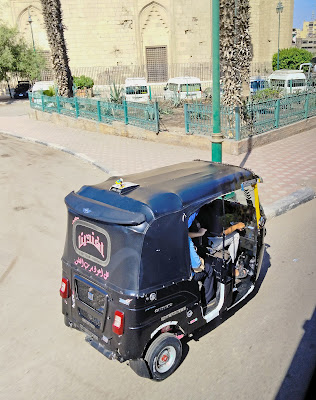Monday, October 16, 2023
 |
The Fairmont Hotel was located near the Imbaba Bridge
(1912-1924 riveted steel truss railway and road bridge with
a single swing span) a couple miles from the heart of Cairo
|
 |
| A street sweeper is literally on the street |
 |
Equestrian statue (1872, by Charles Cordier) of
Ibrahim Pasha, son of Muhammed Ali, in Al Opra Square |
Our included excursion of the day started off with the Cairo Citadel/Citadel of Saladin.
 |
| Wherever we go, we see dogs taking naps and stray cats (KSS) |
 |
The Citadel (1176-1182, to protect Cairo from Crusader
attacks, with modifications 1310-1341, and 1805-1848);
this is the largest tower, Burg al-Muqattam |
 |
We were here to visit the Mosque of Muhammed Ali
(1830-1948, by Yusuf Boshnak in Ottoman Turkish style);
the alabaster panels were removed from the upper walls
to be used in the construction of later palaces |
Muhammed Ali was a military commander of the Albanian Ottoman force sent to recover Egypt from French occupation under Napoleon. He became governor of Egypt, ruling from 1805-1848. He is considered the founder of modern Egypt, because of dramatic military, economic, and cultural reforms, although he did not accomplish formal independence of the country.
 |
| Ironwork window grille |
 |
| Outer courtyard with a marble ablution fountain (1828) |
 |
| A tourist pretends to wash at the ablution fountain |
 |
Iron clock tower (1846) presented to
Muhammed Ali by French King Louis Philippe,
not necessarily in return for the Luxor Temple
obelisks that Muhammed Ali gifted to France
in 1830, one of which stands in Paris in
the Place de la Concorde (the second obelisk
never made it to France and finally in 1981
France renounced possession of this obelisk) |
The French clock is reported to have rarely worked, and still does not show the correct time despite renovation and automation in 2021.
 |
Inner court wth chandelier (where we had
to wear covers on our shoes - rather
than remove the shoes) |
 |
Seen is one of two minbar/pulpits (the second has
a taller flight of steps on the right); in the center of the
back wall is the marble mihrab/niche closest to Mecca |
 |
| View over the city of Cairo from the Citadel |
 |
| SW side of Muhammed Ali Mosque |
 |
View toward Al-Nasir Muhammad ibn Qalawun Mosque
(1318, in Mamluk style), which had been stripped bare
by the Ottomans (i.e., Muhammed Ali) |
Mamluks were originally enslaved mercenary soldiers who became a powerful knightly class under the control of Arab rulers. Mamluks were credited with expelling the last of the Crusaders from Egypt and the Levant/Easter Mediterranean, and thus began a period of stability and prosperity under Al-Nasir Muhammed.
 |
| SE side of Muhammed Ali Mosque |
 |
| Interesting hedge trimming |






















No comments:
Post a Comment